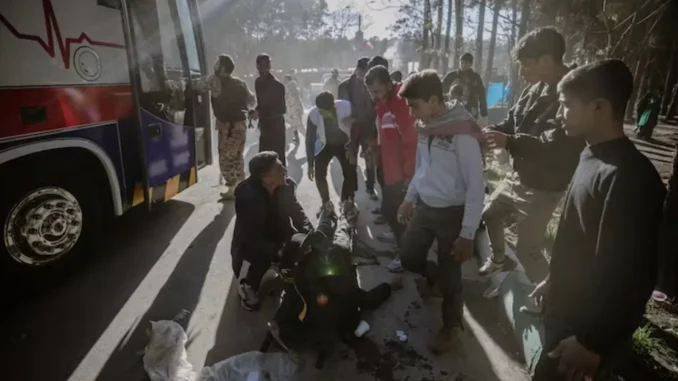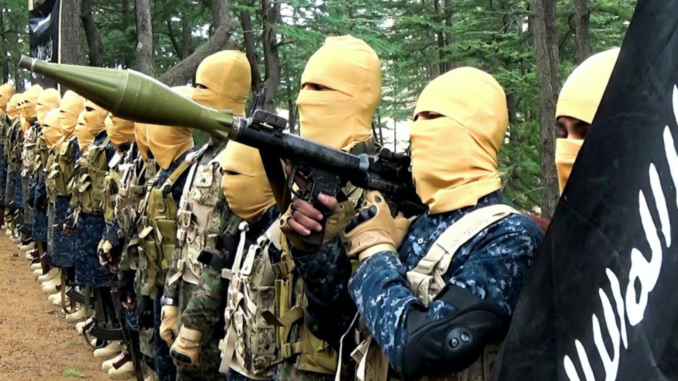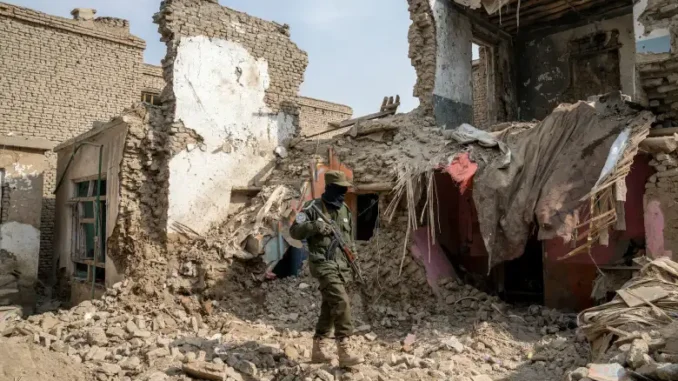Terror attack on Iran shows Afghanistan-based militant group is expanding and intensifying its regional reach and influence.
By Amira Jadoon and Nakissa Jahanbani, ASIA TIMES 12 Jan 2024

More than 100 people were killed in the blast in Kerman, Iran, on January 3, 2024. Photo: Mahdi / Middle East Images / AFP via Getty Images
Since the Taliban takeover of Afghanistan in 2021, the terror group Islamic State Khorasan Province, or ISIS-K, has sought to internationalize its operational and recruitment campaign.
Utilizing a sweeping propaganda campaign to appeal to audiences across South and Central Asia, the group has tried to position itself as the dominant regional challenger to what it perceives to be repressive regimes.
On January 3, 2024, ISIS-K demonstrated just how far it had progressed toward these goals. In a brutal demonstration of its capability to align actions with extreme rhetoric, ISIS-K claimed responsibility for a bomb attack in Kerman, Iran, which resulted in the deaths of over 100 people.
The blast, which was reportedly carried out by two Tajik ISIS-K members, occurred during a memorial service for Qassem Soleimani, a Lieutenant General in the Islamic Revolutionary Guard Corps who was killed in a US drone strike in 2020.
ISIS-K claimed the attack as an act of revenge against Soleimani, who spearheaded Iran’s fight against the Islamic State group and its affiliates prior to his death.
As experts in ISIS-K and Iran, we believe the attack highlights the success of ISIS-K’s recruitment strategies and its growing ability to strike declared enemies and undermine regional stability.
The attack in Iran was not completely unexpected to those monitoring ISIS-K. A paper one of us co-wrote in 2023 noted that despite setbacks, including the loss of key personnel, ISIS-K was expanding and intensifying its regional influence. It was achieving this by leveraging its ethnically and nationally diverse membership base and ties to other militant groups.
The Kerman blast follows two other recent attacks on the Shahcheragh shrine in Shiraz, Iran, in October 2022 and August 2023 – both purportedly involving Tajik perpetrators.
The involvement of Tajik nationals in the Kerman attack underscores Iran’s long-standing concerns over ISIS-K’s recruitment strategies, which have seen the group swell its members by reaching out to discontented Muslim populations across South and Central Asian countries and consolidating diverse grievances into a single narrative.
Strategic diversity
This strategy of “internationalizing” ISIS-K’s agenda – its aim is the establishment of an Islamic caliphate in Central and South Asia – has been pursued with renewed vigor since 2021. This is in part due to a more permissive environment following the U.S. withdrawal and the subsequent collapse of the Afghan government.
This process of internationalizing ISIS-K’s agenda involves the group targeting regional countries directly, or their presence within Afghanistan. To date, this has seen interests from Pakistan, India, Uzbekistan, Tajikistan, China and Russia targeted by terrorist attacks.
Meanwhile, strikes against Iran have long been foreshadowed in ISIS-K propaganda.
 Islamic State-Khorasan fighters at the Sheikh Jalaluddin training camp in Afghanistan in a file photo. Photo: Facebook
Islamic State-Khorasan fighters at the Sheikh Jalaluddin training camp in Afghanistan in a file photo. Photo: Facebook
In parallel, the group’s multilingual propaganda campaign interwove a tapestry of local, regional and global grievances to recruit and mobilize supporters from a vast demographic spectrum, and potentially inspire supporters from afar.
In other instances, this has seen the terror group partnering with anti-government and sectarian militant networks in both Afghanistan and Pakistan, collaborating with groups such as the Lashkar-e-Jhangvi and the Islamic Movement of Uzbekistan.
But moreover, ISIS-K is attempting to capture the South and Central Asian militant market for itself. By utilizing fighters representative of regional religious and ethnic populations and publicizing their attacks, ISIS-K is signaling its commitment to a comprehensive jihadist agenda.
The Tajik connection
The involvement of Tajik recruits in the Kerman attack can be understood within this broader context of ISIS-K’s intentional strategic diversification.
Concerns around Tajik nationals’ recruitment into ISIS-K have existed for a while, with the Taliban’s draconian treatment of Afghanistan’s minorities, including Tajiks, likely creating an unwitting recruitment boon for the terror group.
Several Tajik nationals were arrested in relation to a plot against US and NATO targets in Germany in April 2020. More Tajik ISIS-K members were arrested by German and Dutch authorities in July 2023 as part of an operation to disrupt a plot and ISIS-K fundraising.
The attack in Iran represents a continuation of this process of internationalizing ISIS-K’s violent campaign.
But the bombing is significant for another reason: It takes ISIS-K’s fight directly to a symbol of Shia leadership.
A deadly attack against Iran, a formidable Shia state, lends ideological credence to ISIS-K’s words in the eyes of its followers. It also potentially facilitates the recruitment of individuals who are proponents of anti-Shia ideologies in the Muslim world.
More than any other Islamic State affiliate, ISIS-K is uniquely positioned to exploit the vestiges of the deeply embedded, decades-old Sunni-Shia divide in the region.
Iran’s proxies and the Taliban
This isn’t to say that the attack on Iran was purely opportunistic. ISIS-K has deep-rooted antipathy toward Iran due to Tehran’s religious, social and political involvement in Afghanistan and Pakistan.
Iran’s involvement has been multifold, from supporting political and militant groups such as al-Qaeda and the Taliban to recruiting fighters from Afghanistan and Pakistan for operations against Sunni militants.
Additionally, during the two decades of war in Afghanistan, several Taliban factions reportedly received weapons and funding through Iran’s Quds Force, which carries out missions outside Iran as an arm of the paramilitary security institution Islamic Revolutionary Guard Corps, or IRGC. By 2018, leaders in Tehran viewed the Taliban as a buffer against ISIS-K.
 A Taliban fighter checks a destroyed ISIS-K safe house on Feb. 14, 2023. Photo: AP via The Conversation / Ebrahim Noroozi
A Taliban fighter checks a destroyed ISIS-K safe house on Feb. 14, 2023. Photo: AP via The Conversation / Ebrahim Noroozi



The enemies of my enemies are “sometimes our friends”!
As de Gaul stated eloquently: ” France has no friends, only interests”!
Is it good for the Jews?
Extremely informative report. Reading it is the first time I have been able to make sense of the attack on the Iranians paying their respects to Soleimani on his “yahrzeit” (!?)